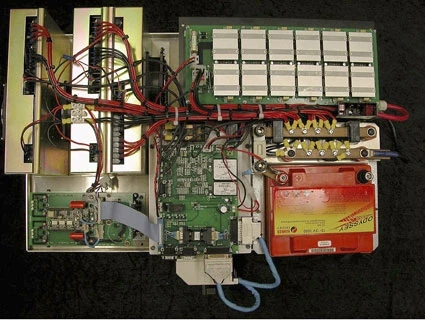November 24, 2004 Holden has announced an Australian based joint research program with CSIRO to explore future global powertrain technologies. The program will contribute to parent company General Motors' mission to design and develop hybrid and hydrogen-powered fuel cell vehicles.
Holden Chairman and Managing Director, Denny Mooney, announced the joint program at the GM 'Road To Hydrogen' seminar in Sydney, where participants were able to drive Hy-wire, the latest hydrogen fuel cell concept vehicle from GM which could revolutionise the way future cars are developed.
"This collaboration between Holden and CSIRO, with its undoubted world-class research capabilities, sees Australia's leading R&D investors in the public and private sectors playing their part in the global road to hydrogen," Mr Mooney said.
"This program will focus on technology which could have wide-ranging future applications in hybrid and fuel cell systems. Australia is in the region which will experience more than half the world's growth in car use in the next decade - the Asia Pacific.
"General Motors is harnessing its broad powertrain expertise and economies of scale as the world's largest automotive company to make a definitive difference, to move towards the day when cars are largely removed from the environmental debate.
"Holden has played a leadership role in local automotive research for many years. It is Australia's biggest private research and development spender investing more than $540 million in the past two years alone. Holden Innovation, which will drive the new project, is also Australia's only stand-alone automotive R&D centre," Mr Mooney said.
Holden and CSIRO began collaborative research into alternative propulsion systems with the ECOmmodore hybrid electric vehicle project in 2000. It has provided the platform for continuing research into the supercapacitor and battery technologies which could play an important role in the development of hydrogen fuel cell and hybrid applications.
Holden Innovation's Chief Engineer, Dr Laurie Sparke, said the project's research activity would be focused on power management systems and energy storage technologies.
"Electric propulsion will be the basis of practically all vehicle powertrains in the long term. These electric drives, regardless of the origin of the power source, will require electrical energy storage devices such as supercapacitors, batteries, or a combination of both," Mr Sparke said.
"Supercapacitors are our particular interest. They're capable of providing a rapid surge of power and allow the super-fast collection, storage and discharge of the electrical energy necessary for automotive applications. They're lightweight and suited to capturing or providing the high currents associated with regenerative braking and full throttle acceleration.
"Using supercapacitors, our engineers can minimise electric loads which can drastically reduce battery life and allow better management of the 'rapid change of state' events associated with day-to-day driving.
"The beauty of our supercapacitor power management and storage systems is that they have the flexibility to be used in different applications under different programs, no matter what the hybrid or fuel cell powertrain needs.
"Although Australia remains a small player in the global automotive industry, we believe that we can make a worthwhile local contribution to General Motors' goals.
"GM is intent on applying new technologies that will improve our vehicles, making them safer, cleaner and more efficient so that they are minimised as a factor in the environmental equation," Mr Sparke said.
GM's Road to Hydrogen The Sydney seminar outlined strategies General Motors has in place to provide a bridge to the hydrogen economy. The company believes the long-term answer to the question of sustainable mobility lies inhydrogen-powered fuel cells from renewable resources.
Fuel cells produce electricity from hydrogen and oxygen to power an electric source. They are more than twice as energy-efficient as internal combustion engines and emit only water vapour.
One of several GM hydrogen fuel cell concept vehicles, the revolutionary Hy-wire test-driven by seminar participants has a hydrogen fuel cell propulsion system housed entirely in a 25cm thick skateboard-like chassis. By-wire controls attached to the chassis through a single docking port use electrical signals instead of mechanical links or hydraulics to control steering, acceleration and braking. Without an engine, steering column or other conventional vehiclecomponents, the Hy-wire concept provides unprecedented design freedom.
While volume production of such hydrogen fuel cell vehicles is a long way off, the GM focus is on generating maximum results in a series of stages. It is increasing the efficiency of internal combustion engines by a variety of means, including such technologies as 'displacement on demand', which shuts down half the cylinders on V6 and V8 engines when they're not needed.
General Motors also has three different hybrid systems in development or production and has introduced hybrid powertrains on heavy fuel users such as passenger buses. Up to 90 per cent cleaner than conventional counterparts, GM hybrid buses now operate in more than a dozen US cities. Several hybrid versions of high-volume GM passenger and sports utility vehicles will next year join hybrid pickups already on the market.
To prepare the way for a hydrogen economy, GM supports recommendations made by a 2002 global forum on personal transportation hosted by the US Secretary of Energy. The first is to encourage governments to invest research and development funding into fuel cells. The second is that nations should be early consumers of fuel cell vehicles to provide the seeds of growth and create momentum for new technologies. Next, nations should adopt minimum and harmonised codes and standards of hydrogen infrastructure and fuel to avoid creating a maze of rules and policies. Finally, nations should commit to and implement a global hydrogen infrastructure.












